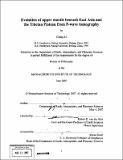| dc.contributor.advisor | Robert D. van der Hilst. | en_US |
| dc.contributor.author | Li, Chang, Ph.D. | en_US |
| dc.contributor.other | Massachusetts Institute of Technology. Dept. of Earth, Atmospheric, and Planetary Sciences. | en_US |
| dc.date.accessioned | 2008-03-27T18:30:32Z | |
| dc.date.available | 2008-03-27T18:30:32Z | |
| dc.date.copyright | 2007 | en_US |
| dc.date.issued | 2007 | en_US |
| dc.identifier.uri | http://hdl.handle.net/1721.1/40964 | |
| dc.description | Thesis (Ph. D.)--Massachusetts Institute of Technology, Dept. of Earth, Atmospheric, and Planetary Sciences, 2007. | en_US |
| dc.description | Includes bibliographical references. | en_US |
| dc.description.abstract | The main objective of the research presented in this thesis is to improve our understanding for the evolution of the upper mantle beneath East Asia and the Tibetan Plateau through high resolution P-wave tomography. The approach to high resolution tomography is based on (i) the combined use of a large range of different types of seismic data, (ii) the use of approximate finite frequency sensitivity kernels to account for difference in measurement technique and frequency content of the data, (iii) the use of an irregular grid with cell-size adapted to sampling density, and (iv) the use of a priori information, e.g., on crustal structure from receiver function analysis. I construct a multi-scale and high resolution seismic tomography model of the upper mantle structure beneath East Asia and the Tibetan Plateau. The new model reveals that the mantle structure associated with the Indian subduction varies considerably along the strike of the collision zone. From west to east, the dip angle of Indian subduction increases and the distance over which the plate underthrusts the Tibetan Plateau decreases. Oblique subduction and changes of dip angle in the central part of the collision zone may cause and determine the location of the north-south trending normal faults in central Tibet. The eastward retreating slabs of western Pacific and Philippine plates are deflected in the transition zone beneath the Korea, Japan Sea, and East China. Some of Mesozoic subducted slabs have reached as far west as 1100E longitude under the Yangtze Craton, which might have resulted from the Eocene subduction at the South China and Japan trenches. | en_US |
| dc.description.abstract | (cont.) Precambrian continental roots under Ordos block and Sichuan Basin, which extend to 250-300 km depth, may form a boundary of transition in tectonic regimes from the India-Eurasia collision control in the southwest to Pacific, Philippine Sea, and Java-Sumatra subductions control in the east and southeast. I conclude that the (direct) influence of the India-Eurasia collision on the tectonic evolution of East Asia may be confined to the Tibetan plateau and vicinity, whereas the tectonic development of a large area east and southeast of Ordos, Sichuan and Burma is driven by the stress field and 3-D upper mantle processes associated with subductions of Pacific, Philippine Sea, and Indo-Australia plates. | en_US |
| dc.description.statementofresponsibility | by Chang Li. | en_US |
| dc.format.extent | 196 p. | en_US |
| dc.language.iso | eng | en_US |
| dc.publisher | Massachusetts Institute of Technology | en_US |
| dc.rights | M.I.T. theses are protected by
copyright. They may be viewed from this source for any purpose, but
reproduction or distribution in any format is prohibited without written
permission. See provided URL for inquiries about permission. | en_US |
| dc.rights.uri | http://dspace.mit.edu/handle/1721.1/7582 | en_US |
| dc.subject | Earth, Atmospheric, and Planetary Sciences. | en_US |
| dc.title | Evolution of upper mantle beneath East Asia and the Tibetan Plateau from P-wave tomography | en_US |
| dc.type | Thesis | en_US |
| dc.description.degree | Ph.D. | en_US |
| dc.contributor.department | Massachusetts Institute of Technology. Department of Earth, Atmospheric, and Planetary Sciences | |
| dc.identifier.oclc | 213092994 | en_US |
